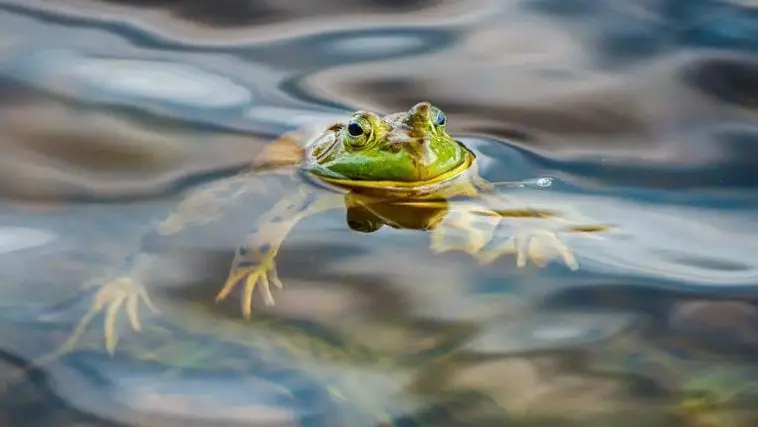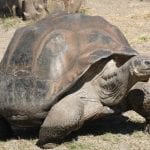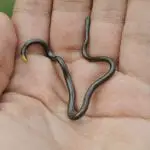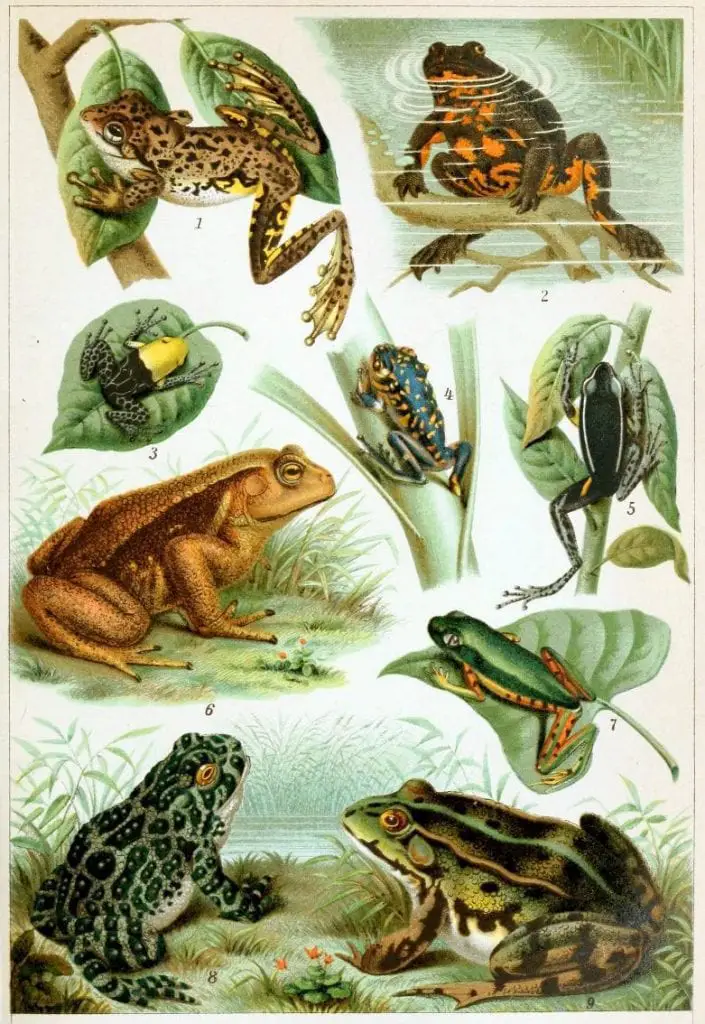
Introduction
In the world, there are over 5,000 frog species, and they have special features allowing them to live successfully in both land and water. The word “amphibian means two lives literally. Frogs live either in or near any pond or freshwater. Then, they lay eggs in clumps. When hatched, tadpoles attach themselves to grass nearby or stems in the body of water. They start their life in the water, having gills and tails.
As they develop, lungs and legs are developed too for life on the land. Tadpoles have a short tail in order to move in the water. As they develop, their tails stay, but the back legs and front legs develop after the other. Their tails get shorter then disappears. The frog is then prepared for a life on the land. They can breathe through their lungs and skin. There is still a need for them to be near the water. With this, they can live in two types of environments. This is one adaptation that frogs have for surviving.
How Do Frogs Adapt in the Water?

Similar to all animals that are specialized their particular habitat, aquatic frogs are naturally endowed with specific characteristics that make them survive in an area that some adapted species could not. On the other hand, if they are adapted exclusively to live in the water, then they rely so much on their habitat to survive. It becomes disadvantageous then if their habitat shrinks or disappears. It would be a risk for them. Fortunately, frogs have their way of adapting.
Fancy Feet
Aquatic frogs are equipped with long legs and extensive webbing found between their toes. This is a big advantage for them. They serve as swimming flippers for better swimming. In addition, the wide area of the webbed toes works as a resistance to water and let them push themselves like having propellers which non-webbed feet animals cannot do.
Sensitive Skin
Their skin is mainly used for adapting to the water. Frogs don’t swallow water but absorb water through their skin instead. Oxygen is absorbed also through their skin. It is a must for them to have a water source. Their sensitive skin makes them vulnerable to be under the heat and sun. To survive, mucus is released on their skin for moisture and protection. This is a slimy feeling. To maintain soft and nice skin, they replenish by removing their old skin to reveal the fresh and new skin under.
Eyes
Frog’s eyes are very useful. They can see in all directions without the need to move their heads or body. It is because their eyes are rounded and large. In addition, they can see although it is dim, including underwater. Their eyes’ location is another advantage too. As it is found on top of their heads, it functions as periscopes for threats like predators.
Frog Coloring
Frogs come in different colors. Some are even very bright. Those with green and darker spots are the aquatic ones. This color blends with their habitat, protecting them for predators or other threats.
Parts of the Body
Their powerful hind legs, as well as their feet, let them jump for long distances. Flat ear discs prevent water from entering their ear canal. Their mouth horizontally opens widely for eating large prey. Their tongues are stick and long for insect catching without moving their bodies. Also, their eggs are clumped together and don’t float away.
How Do Frogs Adapt in Winter?
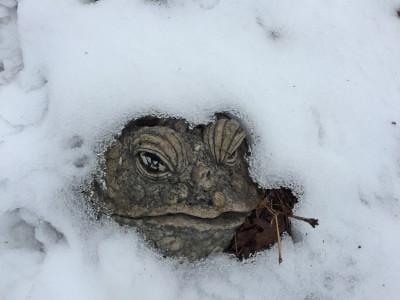
When talking about amazing animals, frogs are one of them. Although they look fragile, frogs have lots of ways to deal with intense climate. Some frogs live in the coldest places. They use two strategies to survive: estivation and hibernation.
Hibernation
Hibernation is a frog’s way of responding to winter. After it finds a living space to protect itself from winter and predator, its metabolism slows down in order to sleep away. Its body uses the energy store. In the spring, the frog wakes up to continue feeding and breeding.
Some aquatic frogs do hibernate underwater. They must be near water rich in oxygen and spend lying on top of the mud. They swim slowly, sometimes. Meanwhile, terrestrial frogs do their hibernation on the land. They dig under the soil below the frost line. Wood frogs find deep cracks in rocks or logs. In addition, there is high glucose in their vital organs to prevent freezing. A frozen frog will partially stop breathing as its heart stops breathing and appear dead. However, when it warms up, the frozen portions thaw and organs continue their activity.
Estivation
Frogs burrow under the soil and become dormant in the dry season. They shed skin layers like a waterproof cocoon and envelop the whole body, just leaving the nostrils for breathing. In the rainy season, they free themselves and comes out of the soil.
How Do Frogs Adapt in the Desert?
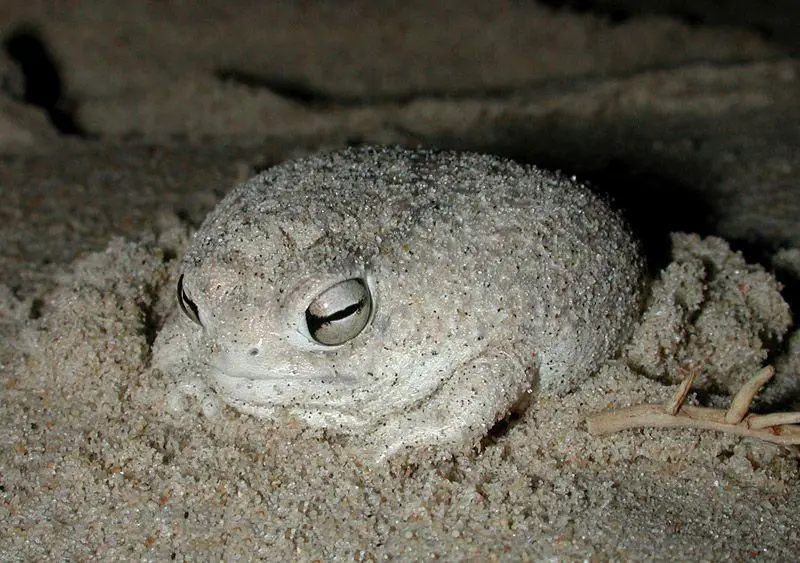
Behavioral
Dessert frogs adapt to a changing environment due to habitat loss taken by diamond miners. They bury themselves too under the sand to keep moist in their skin since they don’t drink water with their mouth; they soak it via their skin.
Physiological
Desert frog’s skin is perfectly colored in order to blend with its habitat. In addition, it has moist skin in the form of mucus that lets sand stick and blend more.
Structural
Desert rain frogs have thick webbed feet for adapting. With it, they can grasp the sand easily.
Five Adaptable Frog Species
1. Red-Eyed Tree Frog
The red-eyed tree frog or the Agalychnis callidryas is a native from the tropical lowlands in southern Mexico extended to northern South America. This frog is a favorite for its adaptations, which are remarkable. Its feature is its bulging red eyes.
In addition to that feature is their neon-green body having blue in a vertical line and yellow stripes found on their sides plus reddish or bright orange feet. when it startled, its color flashes making the predator confuse and run away. This frog has an impressive ability to jump. Its huge and webbed feet have sticky pads for a secure grip for tree climbing and leaping.
2. Amazon Milk Frog
Amazon milk frog is also called the mission golden-eyed tree frog. It is found in the Amazon Rainforest. It has patches of light gray, dark brown, and blue skin plus alternating bands. This frog is beautifully and uniquely colored. Young frogs have the most vibrant colors.
As they get old, their colors fade, and skin becomes granular gradually. This coloration helps them blend into the rainforest trees. The term milk frog is used to describe their white and poisonous secretions in their skin.
3. Goliath Frog
The goliath frog or the Conraua goliath has measurements of 6.5 to 12.5 inches in length and weighs about 1 to 7 pounds. For this reason, it is recognized as the largest frog. They don’t have vocal sacs and uses whistling sound to call a mate. Males are larger than females. they live in the rivers. Sadly, this species is endangered.
4. Mimic Poison Frog
The mimic poison frog or the Ranitomeya imitator is loved for its color patterns and wide variation. It has four morphs that are distinct. Each of them has a vibrant hue. The morphs have gone evolution called the mimetic radiation.
5. White’s Treefrogs
This is the first choice among owners. This frog tolerates handling. That is why this is found in schools and zoos. This is from Australia. A humid to the semi-dry environment is preferred. Its toes have high adhesive pads for climbing. They are 5 inches.
The color is green with yellow or white dots on the sides and back. It can change color as an indication of stress or change in humidity. They breed in summer with a loud croak. Males have vocal sac. They lay eggs in the water.
Other Adaptable Frog Species
1. African Bullfrogs (Scientific Name: Pyxicephalus adspersus)
These are in sub-Saharan Africa. They grow 8 inches. They burrow underground in drought times. They can survive without water or food. they mate and re-emerge on rainy days.
2. African Clawed Frogs (Scientific Name: Xenopus laevis)
They are aquatic and found in streams, puddles, and stagnant pools. They come from sub-Saharan Africa.
3. American Bullfrogs (Scientific Name: Lithobates catesbeianus)
They are found in lakes and streams in the US. Females lay 20, 000 eggs in one time. tadpoles metamorphose up to two years. They have various diets.
4. Borneo Eared Frogs (Scientific Name: Polypedates otilophus)
They are in Sumatra and Borneo, as well as in Indonesia. Females lay their eggs in nests that are attached to tree branches that are overhanging in the water.
5. Giant Monkey Frogs (Scientific Name: Phyllomedusa bicolor)
They are usually found in Amazon and Peruvia. The males make a call usually above the ground, and they go down to the branches to mate. The call is termed as cluck then followed by lower-pitched and short notes.
6. Long-nosed Horned Frogs (Scientific Name: Megophrys nasuta)
They are indigenous to Malaysia, Indonesia, Borneo, and Sumatra. On the forest floor, their veins pointed snouts, and their ridge veins make them disappear in leaf litter.
7. Oriental Fire-bellied Toads (Scientific Name: Bombina orientalis)
They are found in rice paddies, lakes, and ponds in Korea, Russia, and China. For their camouflage, they have black and greenbacks.
Conclusion
Now you are very much aware of the adaptable frogs that keepers would love to have. You can choose the best one that best suits your preference. These frogs are easier to take care of than other types of frogs because they can easily adapt to different environments.

